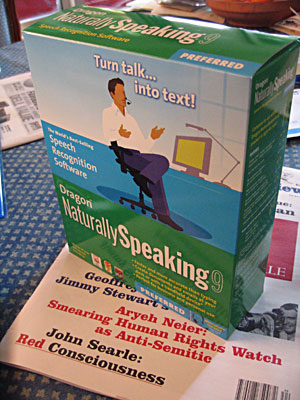
Now here’s a really useful gadget — a marmalade spoon. And no, it’s not something left behind by Uri Geller. Quentin produced it the other day when I arrived seeking breakfast (and a sneak preview of his Nokia E61).


Now here’s a really useful gadget — a marmalade spoon. And no, it’s not something left behind by Uri Geller. Quentin produced it the other day when I arrived seeking breakfast (and a sneak preview of his Nokia E61).

Bet the money’s good, too.
Photographed on the way home the other day.

Because of my arthritis and occasional worries about RSI, I’ve been wanting to try modern dictation software for a while. (I’d tried earlier generations and found them woefully inadequate.) This arrived the other day, and it’s simply stupendous. In fact it’s positively eerie. to be able to talk naturally to a machine and have it faithfully transcribe what you’re saying. It only required about five minutes’ ‘training’ — though I managed to screw up even that. The program offers you a number of scripts from which to read while it’s getting used to your voice. Choices included JFK’s Inaugural speech, a passage from Alice in Wonderland and Dave Barry’s column on “How Computers Work”. Needless to say, I chose Dave Barry. As a result, the training session took much longer than expected because I kept dissolving into hysterical laughter. The only problem is: Dragon software only runs under Windows. But it’s so good that I’m tempted to install XP on my Mac and run it under Parallels so that I can switch seamlessly from OS X to Dragon and back again. That way, I’m selling only half my soul to the devil.

And while we’re on the theme of computing becoming a utility, how about Sun’s new product — a datacentre in a shipping container?
Nicholas Carr has been going on about this for a while, so it’s not surprising that he returns to the theme somewhat gleefully. Still, the facts do seem to be supporting his thesis…
It’s become clear that the slowdown in IT spending is not a passing cyclical event but a secular trend, a reflection of a basic change in the way companies view information technology. That fact was underscored last month when Information Week published the latest edition of its annual survey of IT spending among the “InformationWeek 500” – the companies that it identifies as being the most innovative users of IT. The survey reveals not only that IT budgets haven’t jumped since 2003, but that in fact they’ve continued to erode. Between 2003 and 2006, IT spending as a percentage of revenue has on average fallen from 3.66% to 3.21%. Of the 21 industry sectors tracked by Industry Week, only 5 saw in an increase in IT spending as a percentage of sales over the last three years. In absolute terms, IT expenditures have dropped as well, from an average of $353 million in 2003 to $304 million today. Of those shrinking budgets, moreover, the percentage devoted to purchases of new hardware and software slipped from 37% in 2003 to 34.5% today.
Remember, these are the most innovative users of technology, the ones that set the pace for everyone else…
From Good Morning Silicon Valley…
YouTube’s fascinating catalog of Japanese television clips is quite a bit thinner today, thanks to complaints from an organization representing Japanese copyright holders. The video-sharing site deleted nearly 30,000 files after a Japanese entertainment group requested they be removed, saying they were posted without the authorization of copyright holders. According to The Japan Society for Rights of Authors, Composers and Publishers (JASRAC), an alliance of 23 Japanese TV stations, movie and music companies, 29,549 YouTube-hosted clips were posted in violation of copyright. That’s a pittance when one considers YouTube served up an average of 100 million video streams a day during July. Given that extraordinary number, who will miss a few lizard vs. humans-in-meat-hats game show clips?
Still, this first mass removal of clips should give YouTube boosters pause, because without those 29,549 videos, YouTube is that much less compelling. And if the JASRAC’s request is the beginning of a trend, we could see YouTube becoming increasingly more vanilla as it’s forced to clean up the copyright violations that proliferate on its service. As Forrester analyst Josh Bernoff pointed out earlier this year, this is the Napster scenario all over again. “YouTube is romancing media companies, just as Napster was,” Bernoff wrote. “YouTube will take down copyrighted content if you complain, just as Napster would. And YouTube’s model is based on masses of material available without regard for copyright status, just as Napster’s was. So, mark my words, YouTube will get sued. And it will lose. The tools it is talking about, that identify and remove copyrighted content, will have to be rushed into practice. And when nearly every clip that has copyrighted content — music in the background, video of Bart Simpson, photos stolen from movie posters — is gone, YouTube’s going to be a lot less interesting.”
Exactly. As I was saying only yesterday.
From today’s New York Times…
The world’s largest search engine said yesterday that its third-quarter profits nearly doubled from a year ago, as it maintained a torrid growth rate that is highly unusual for a company of its size.
The numbers are all the more significant because Google’s largest rival, Yahoo, has been faltering, as sales have tapered off for both its search and display advertising.
“Forty-eight hours ago we were discussing Yahoo; the contrast is pretty amazing,” said Jordan Rohan, an analyst with RBC Capital Markets. “This is an eye-opening and refreshing quarter for Google investors.”
In after-hours trading, Google’s shares surged 7.5 percent. In regular trading, before the results were reported, the shares rose $6.75, or 1.6 percent, to $426.06.
Harry Pearson has a wonderfully surreal column about Wayne Rooney. Sample:
These days the top players do not even do their own Little Britain impressions, and they leave the cutting off of the centre-back’s flashy ties to one of their people. This is not because they are lazy. It is because they are focused. The modern player is a specialist. He has little time for anything other than honing the key skills of his profession: shooting, shouting and looking sultry in styling mousse. Nothing distracts him from his job. He has a ghostwriter to write his autobiography and a ghostreader to tell him what is in it.
Some of the biggest names are now so totally devoted to themselves that they even employ a staff of experts to sleep with women for them. “Clearly the players are red-blooded young men who would like nothing better than to chase skirt,” reveals one insider close to the source of a friend, “but as professional athletes they are worried that a night of vigorous heterosexual activity might mess up their aggression, their stamina, or even their hair.”
Some have gone one-step further. A lot of fans and media people have expressed the view that Rooney is experiencing a lack of form. They are quite wrong. Wayne is in the form of his life. Unfortunately his body double is going through a sticky patch, though admittedly not as sticky as the one Frank Lampard’s body double has been experiencing for the past five months.
Some will find the news that Rooney and Lampard actually have body doubles out on the field something of a surprise. It is hard to see why. It has been common practice in Hollywood for years. You wouldn’t expect Angelina Jolie to do her own stunts, or Mel Gibson to show you his own bottom, now would you? Like any movie star Wayne is an incredibly valuable asset. Neither Manchester United nor England can afford to put what we must learn to call “the core of the Rooney brand” at risk by actually allowing him to run around on a slippery surface with a lot of rough blokes. The insurance premiums if they did would be crippling. His beard alone had to be underwritten for £77m…
Terrific Guardian column by Vic Keegan.
The creators of YouTube have done a great service in bringing video creation to the masses. But it was not because their technology was superior to others in the field (it wasn’t), but because they were in the right place at the right time when, unpredictably, YouTube suddenly attracted critical mass. This was a huge victory for garage start-ups over the likes of Google, Microsoft and Yahoo, which found to their cost that the mighty leverage arising from their big market shares in existing products buttered no parsnips in the new world of web creativity.
As a result YouTube, a company that has been mainstream for barely a year, attracted a price tag of $1.65bn, equivalent to almost $25m per employee (not that they will see much of it) or $123 for each of YouTube’s unique monthly users. The figure for those who actually generate the content would be far higher than $123 because only a small proportion of users actually put their own videos up.
Yet without those content creators, YouTube – and Flickr, and all the others – would be nothing. Imagine what would happen if eBay tried to value itself on the basis of all the inventory it held on behalf of its sellers. It wouldn’t because it knows the inventory doesn’t belong to it.
There’s something deeply comical about TechBubble 2.0 — which is what I’ve decided to call the current round of irrational exhuberance. Just to underscore how difficult it is to build and maintain a big, stable company in this febrile space, along come the reports of Yahoo’s difficulties — profits down 38%.
As far as user-generated content goes, the big question — as Vic Keegan says — is: where’s the value? The answer is that it’s in the stuff that people upload. But if people don’t like what you (the new corporate owner) start to do with the space then they can — and will — go elsewhere. Steve Ballmer implied in his BusinessWeek interview the other day, no rational company would have paid $1.65 billion for YouTube. For once, I agree with him.
Thoughtful piece by Michel Thieren in OpenDemocracy…
Two scientifically audited numbers today constitute the best available and most cited evidence quantifying Iraqi civilian deaths directly associated with the war in that country which began in March 2003. Each is generated by a credible and independent source, though their conclusions vary widely: one gives a running total of 48,783 (as of 18 October 2006), the other gives 654,965 for the period March 2003 to July 2006.
At this stage in the Iraq war, these different orders of magnitude for civilian casualties are too often relayed by a number-loving (and sensation-hungry) media in ways that both reflect and serve the preordained views of those in favour of or against the war. A statistical language about Iraqi casualties that is able to bring numbers and words, tallies and stories, into a coherent relationship requires understanding of what “48,783” and “654,965” are really measuring, how they were respectively computed, and what they reveal.
The nub of it seems to be that the lower figure compiled by Iraq Body Count measures only deaths directly attributable to interactions with Coalition forces, whereas the Johns Hopkins figures take into account the suicide bombing, ethnic cleansing and general mayhem now rife in Iraq (and causing 900 violent casualties aday).